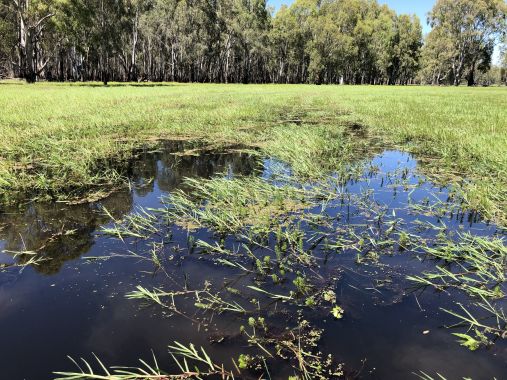The 2021-22 delivery of water for the environment to the Barmah-Millewa Forest was another step in a journey spanning more than 10 years to restore Moira grass on the floodplains, which in 2009 had fallen to just five percent of its original coverage.
Barmah-Millewa Forest is the largest and most intact freshwater floodplain system on the Murray – and the largest river red gum forest in Australia, which makes it the biggest ecosystem of its type in the world. The forest’s floodplains provide critical habitat for threatened turtles, frogs and many waterbirds and insects.

Image: Barmah-Millewa Forest, by Goulburn Broken CMA
Recognised internationally under the Ramsar convention, the Living Murray icon site is also one of the last strongholds of Moira grass in Victoria.
In 2009, it became clear that without multi-year environmental flow deliveries the floodplain grass was predicted to become locally extinct as early as 2026.
Knowledge built up over decades of scientific studies had indicated manipulating the watering regime and controlling large, introduced herbivore grazing pressure was the most effective management option – and the science had indicated what specific watering the Moira grass needed.
That watering requirement has been proven, 13 years on. Monitoring has confirmed that Moira grass responds best to regular inundation at about 0.5 metres in spring, with water staying on the Moira grass plains for a minimum of three months, followed by a drying cycle no earlier than December.
There have been further learnings along the way. Environmental water holders and waterway managers have each year assessed what management has the best chance to increase the frequency of flowering years, the size of the area covered by the grass, and to create a grass thatch thick enough to weather drying cycles.
The winter-spring 2021 delivery of environmental flows was the fifth time the water had been managed to replicate natural flows onto the floodplain through winter and spring, by opening water regulator structures regardless of river levels. This method of delivery has allowed the floodplain water to connect with the river more gradually and monitoring has confirmed the watering technique results in strong Moira grass growth and flowering.
Water for the environment deliveries were paused when natural flows were greater than 15,000ML/d downstream of Yarrawonga so as to prevent third party impacts.
Approximately 60 percent of Barmah and Millewa forest floodplain (55 percent of the forest reserve) was inundated from the peak spring natural flood event. Although water for the environment alone can only be delivered up to a level that inundates around 17 percent of the floodplain (15 percent of the reserve), its importance lay in slowing natural flood peak recession and maintaining duration of ponding to permit critical ecosystem responses to be achieved.
Recent strategies have tested the value of exclusion fencing to keep out feral horses. The naturally open Moira grass plains are like nature’s own cleared and irrigated pasture – with the nutritious grass highly attractive to grazing animals. Feral horses are considered to be highly destructive through their grazing, browsing and trampling pressure. They rapidly crop the grass to ground level when floodwaters subside and eat the stems even when it is dry.

Image: Top Lake Exclusion Fence in Barmah-Millewa Forest showing extensive moira grass coverage where grazing animals have been excluded, by Keith Ward at Goulburn Broken CMA
Grazing pressure removes flower heads and therefore has a direct impact on re-seeding, and also frequently sees entire plants consumed. To test the impact of grazing and protect the regenerating Moira grass from horses, exclusion fencing was trialled, with monitoring from May 2021 showing in one site an increase in coverage of 2000 percent when combined with environmental watering over a 12-month period.
This great result further informed the 2021-22 environmental watering proposal.
The delivery of around 200,000ML to Barmah Forest (with around 140,000 ML of the volume delivered returned to the river for downstream use) achieved the outcomes as without the delivery, river regulation would have otherwise prematurely dropped the desired water level before Moira grass have flowered and waterbirds had fledged.
“The once extensive Moira grass marshlands are showing substantial improvement with active management, specifically by fencing remnant patches to exclude large herbivores, and improved delivery of environmental water to support plant vigour and recruitment,” Goulburn Broken CMA Environmental Water Reserve Manager, Keith Ward, said.
Before the Murray River was regulated, the Barmah-Millewa Forest would have experienced more frequent flooding with high flows from rainfall in winter and spring. Without environmental water, the Moira grass would only have been achieved the right levels of inundation four to five times in the last 13 years (compared to eight to nine times if river regulation had not been in place over that same period).